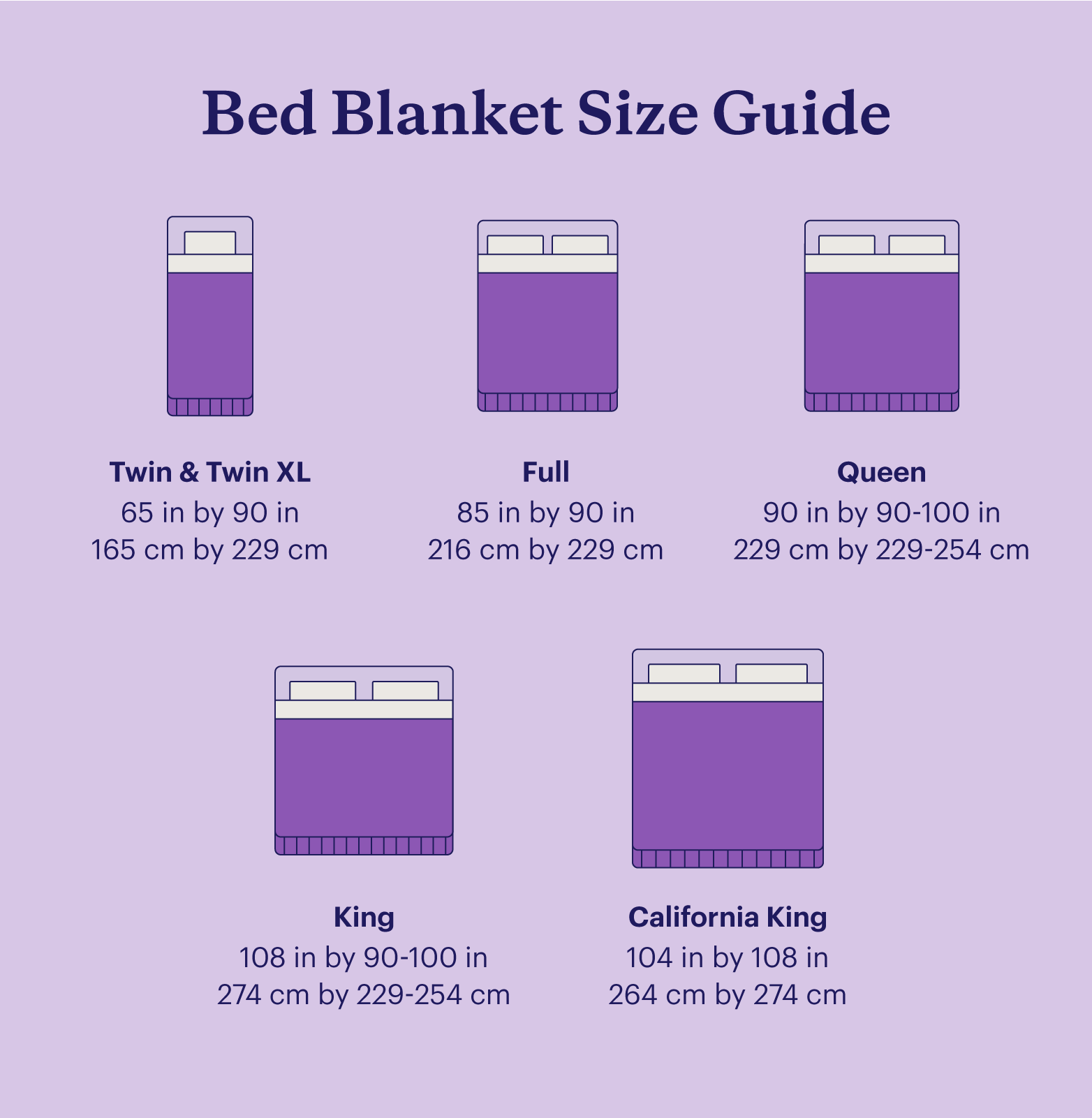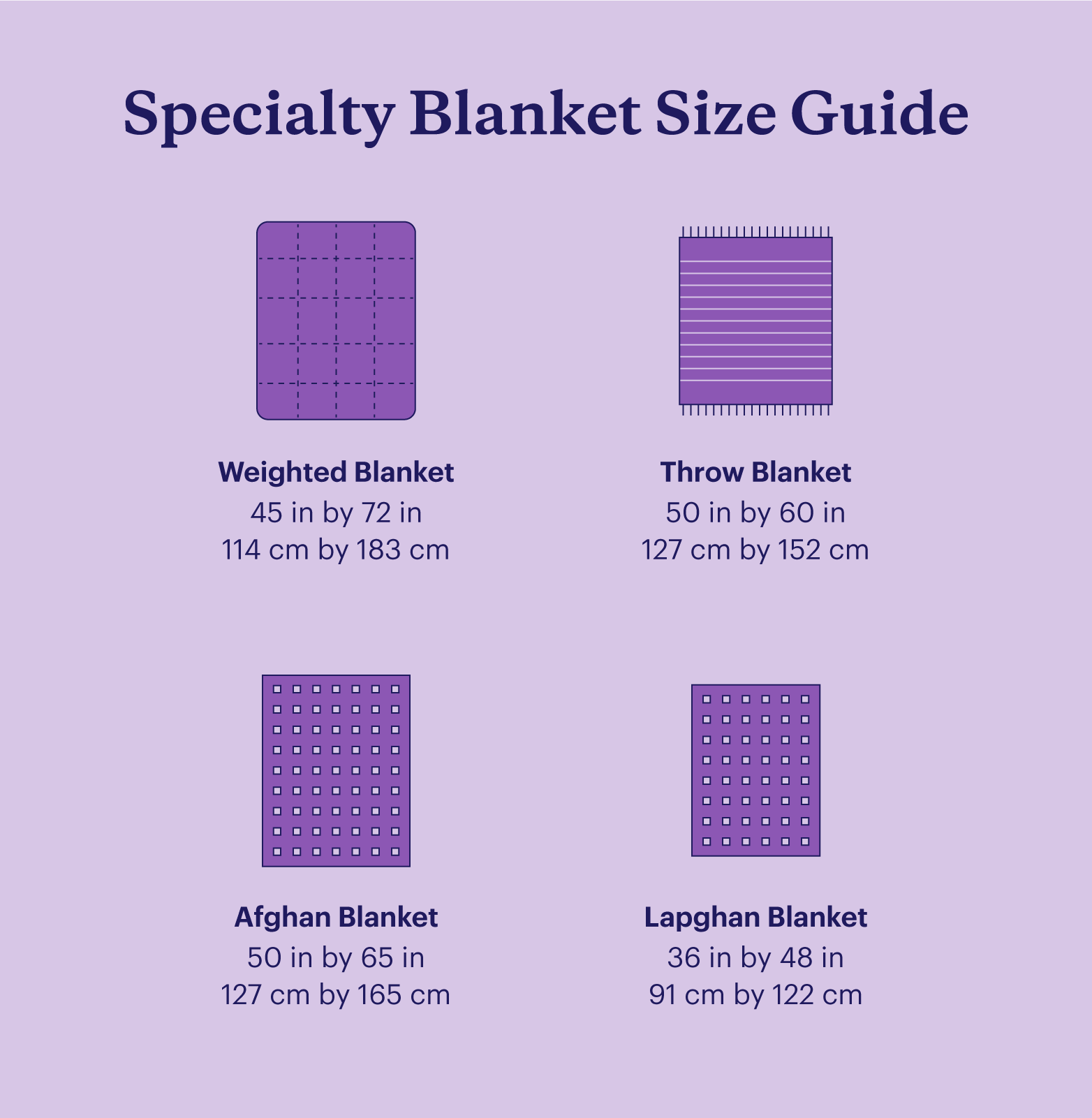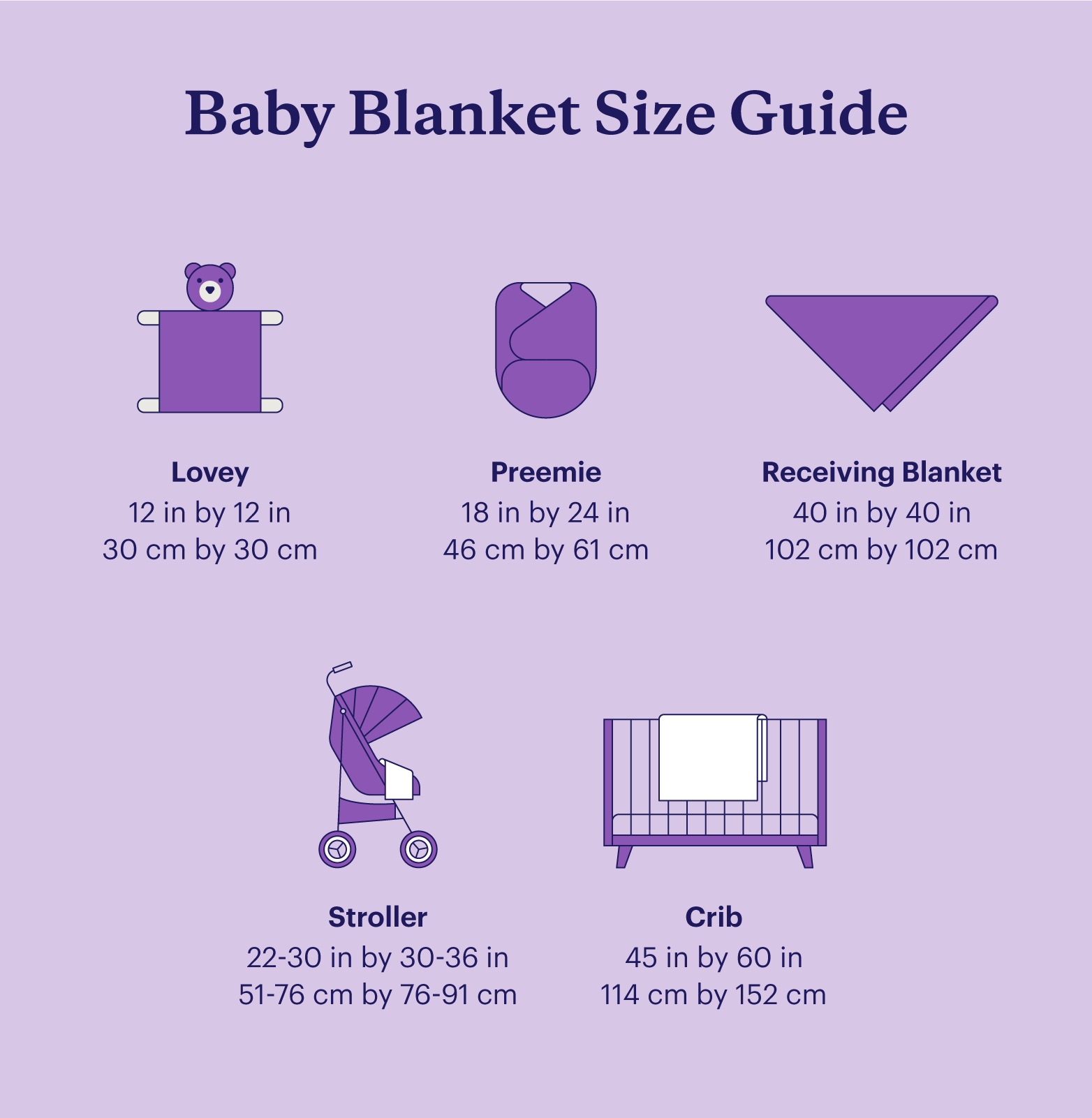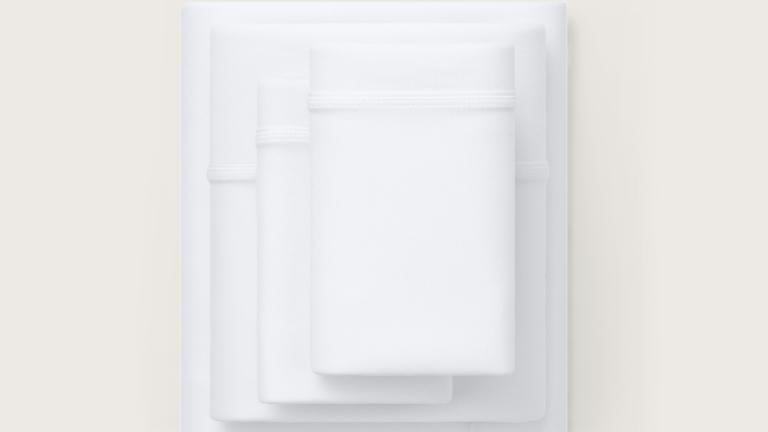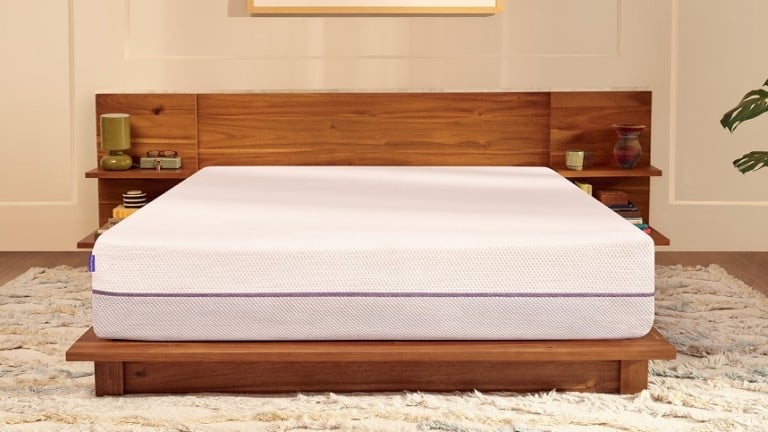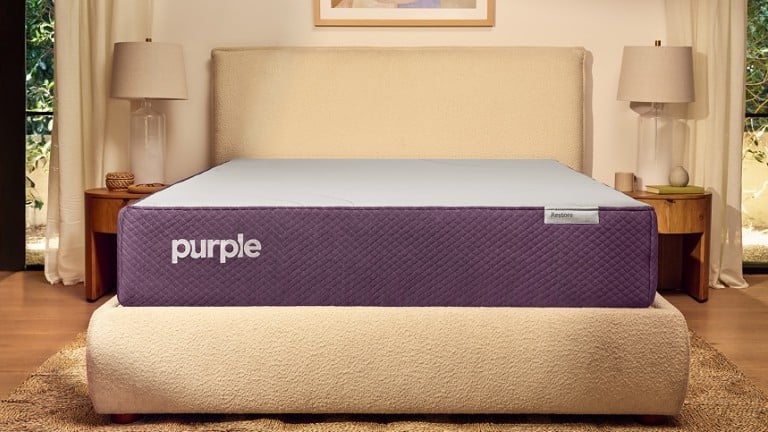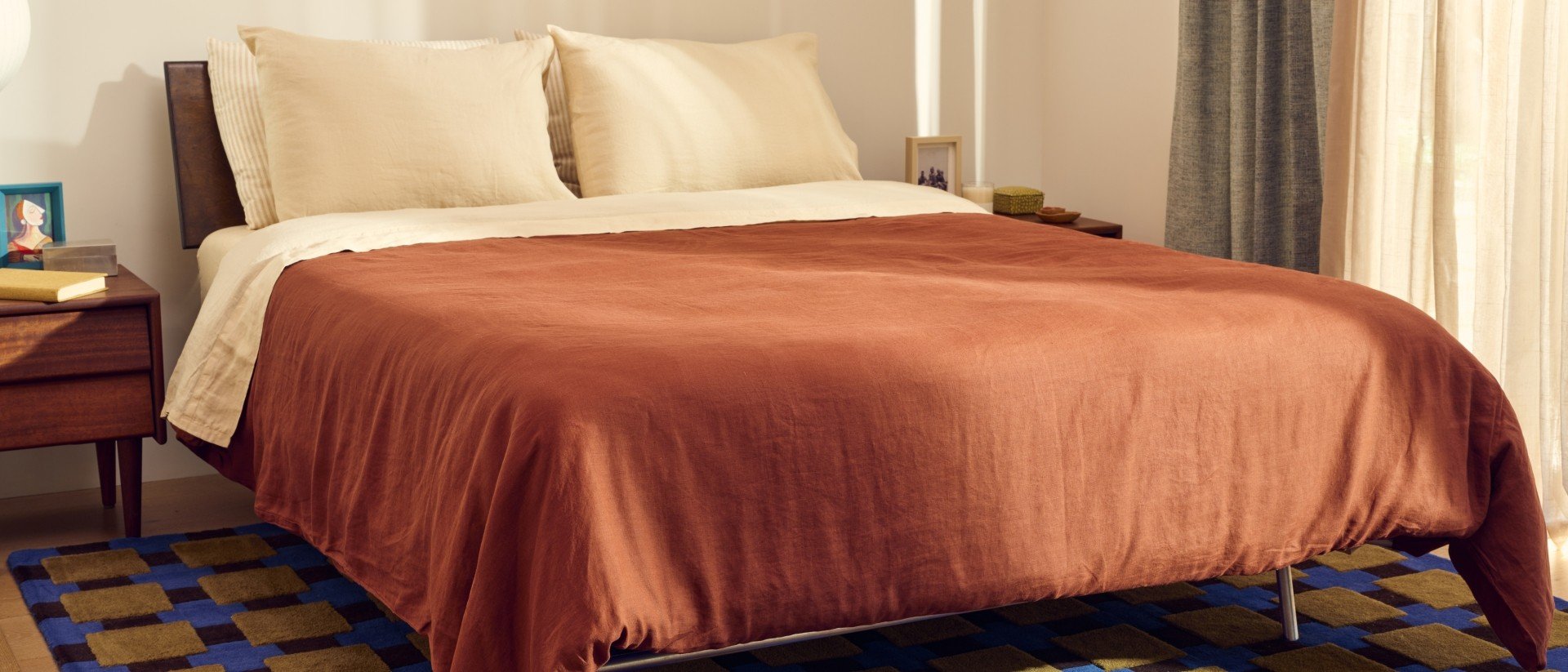
Blanket Sizes Guide: Dimensions, Types, and Comparison Chart
Key Takeaways
- Blanket sizes can vary based on the manufacturer, so do your research prior to purchasing.
- Consider sizing up if you have a taller mattress or want an oversized fit.
- When choosing a blanket for sleep, consider its size, function, material, warmth, layering, care, and features.
Choosing the wrong size blanket can be frustrating and negatively affect your sleep, leading to half-covered beds, cold feet, or your blanket piling up on the floor. Whether you make your bed every morning or just want your bedding to be where you want it when you need it, choosing the right size blankets can make a big difference in your comfort.
Keep reading our blanket size guide to learn about different blanket sizes as well as how to choose the right blanket for sleep.
Blanket Sizes Chart
Comparing blanket sizes is just as important as deciding what bed sheet size you need.
Exact blanket sizes vary based on the manufacturer, so it's important to do your research before making a purchase. To help you determine the best blanket size for your needs, we’ve compiled the dimensions of the most common types of blankets.
Size | Dimensions (inches) | Dimensions (centimeters) |
California king | 104-by-108 | 264-by-274 |
King | 108-by-90-to-100 | 274-by-229-to-254 |
Queen | 90-by-90-to-100 | 229-by-229-to-254 |
Full | 85-by-90 | 216-by-229 |
Twin and twin XL | 60-by-90 | 152-by-229 |
Afghan | 50-by-65 | 127-by-165 |
Throw | 50-by-60 | 127-by-152 |
Crib | 45-by-60 | 114-by-152 |
Receiving | 40-by-40 | 102-by-102 |
Lapghan | 36-by-48 | 91-by-122 |
Stroller | 20-to-30-by-30-to-36 | 51-to-76-by-76-to-91 |
Premie | 18-by-24 | 46-by-61 |
Cradle | 14-by-30 | 36-by-76 |
Baby | 14-by-16 | 36-by-41 |
Lovey | 12-by-12 | 30-by-30 |
Before you start shopping for a cozy blanket, invest in high-quality sheets to protect your mattress and keep you comfortable.
Standard Bed Blanket Sizes
As the name suggests, a bed blanket is sized to be the perfect fit for your bed, similar to bed sheets and pillow sizes. Blanket and comforter sizes for beds are usually a few inches wider and longer than your mattress.
California king blankets
Dimensions: 104-by-108 inches
Like the mattress, a California king blanket is longer and narrower than a standard king blanket. This makes it a suitable choice for California king mattress owners and anyone looking for a large blanket with some extra length to sleep soundly on colder nights.
King blankets
Dimensions: 108-by-90-to-100 inches
A king blanket is the go-to for king bed sleepers and anyone who wants an extra-large blanket to lounge and sleep under. This also makes it a perfect choice for couples and those who sleep alongside pets and children.
Queen blankets
Dimensions: 90-by-90-to-100 inches
While this blanket works best on a queen mattress, you can add one to a
full bed if you need extra coverage. Some queen blankets are often marketed as full/queen blankets and can work for either size.
Full blankets
Dimensions: 85-by-90 inches
If you have a full or double bed and are looking for a blanket to add extra warmth while you sleep, consider a full size bed blanket. Keep in mind that some full bed blankets are branded as full/queen size blankets, making them a suitable option for both bed sizes.
A full/queen size bed blanket will provide slightly less overhang for a queen bed and ample overhang for thicker full size mattresses.
Twin and twin XL blankets
Dimensions: 65-by-90 inches
A twin or twin XL blanket is a great way to keep single sleepers with a smaller bed comfortable and warm without needing an oversized blanket that drapes to the floor.
These blankets can also be perfect for couples with different temperature preferences or sleep styles to ensure everyone has their desired blanket coverage throughout the night. Adding a twin or twin XL blanket to a larger bed can provide adequate coverage for a single sleeper, ensuring they can sleep tight without overheating their partner.
Specialty Blanket Sizes
While bed blankets are primarily for the bed, specialty blankets serve different purposes, from keeping your legs warm to adding a bit of decor to your couch or chair.
Afghan blankets
Dimensions: 50-by-65 inches
Afghan blankets are slightly larger than most throw blankets and typically add a decorative touch to bedrooms or living rooms.
Throw blankets
Dimensions: 50-by-60 inches
Throw blankets are lighter blankets that people often drape over a couch or at the foot of the bed. Ranging in design and material, throw blankets can serve as accents or provide extra warmth when sleeping in bed or lounging on the couch. Compared to bed blankets, throw blankets are usually much smaller.
Lapghan blankets
Dimensions: 36-by-48 inches
As the name suggests, lapghan blankets are smaller Afghan blankets sized for your lap. Their size makes them perfect for draping over the back of a chair or couch, adding a touch of color and a layer of warmth whenever you need it.
Baby Blanket Sizes
If you're looking for a blanket to help keep your little one snug and cozy, you can choose from a few popular sizes. But the American Academy of Pediatrics recommends against using blankets in cribs until infants are at least one year old. When in doubt, always consult your pediatrician with specific questions.
Crib blankets
Dimensions: 45-by-60 inches
Crib blankets are larger baby blankets designed to fit in cribs or toddler beds. As a reminder, the AAP recommends keeping all blankets outside of your baby’s sleeping space until they are one year old.
Receiving blankets
Dimensions: 40-by-40 inches
Receiving blankets are large square blankets used for swaddling infants. In some cases, receiving blankets come in packs so you can easily swap them out when it's time to wash them.
Stroller blankets
Dimensions: 20-to-30-by-30-to-36 inches
Stroller blankets are slightly smaller than receiving blankets. As the name suggests, these blankets help cover your child while they’re in a stroller.
Preemie blankets
Dimensions: 18-by-24 inches
Preemie blankets, which are 18-by-24 inches, and are most common in the neonatal intensive care unit (NICU). They are used to swaddle babies until they are old enough to leave.
Cradle blankets
Dimensions: 14-by-30 inches
Made for infants, cradle blankets are a great size to tuck around a baby in a cradle, keeping them snug and warm. You can also use slightly larger blankets in a cradle, but these blankets are specifically designed for this purpose.
Baby blankets
Dimensions: 14-by-16 inches
Baby blankets are commonly given to infants and toddlers as comfort items. They can provide warmth and a sense of security.
Lovey blankets
Dimensions: 12-by-12 inches
Lovey blankets are small square blankets babies can use to seek comfort in new situations. These blankets often have an attached stuffed animal and are designed to provide a sense of security for your baby.
How To Choose the Best Blanket for Your Bed
When choosing a blanket for sleep, size is only one factor affecting your comfort. Follow along to learn how to choose the right blanket sizes for restful and restorative sleep.
1. Consider Function
When choosing between different types of blankets, ask yourself what you’ll be using them for. If you need a blanket for your bedroom to stay warm during winter, you’ll likely enjoy a bed blanket that fits your mattress perfectly. If you’re looking for more of a decorative accent, you may want to go with a lighter throw blanket with intricate patterns and vibrant colors.
Just like choosing a comforter, you should think about how warm you want it to be. You can do this by considering factors like:
- Weather
- Time of year
- Desired sleeping temperature
2. Select Your Materials
Once you’ve decided what you’ll use your blanket for, it's time to pick a material. Common blanket materials include:
- Cotton: Cotton is a natural and breathable fabric known for its softness, ease of care, and durability.
- Fleece: Fleece is a lightweight synthetic fabric that traps heat and provides warmth. It is also moisture-resistant and quick-drying, making it a popular choice for cold or damp conditions.
- Flannel: Flannel is a soft material often featuring checkered and multicolored designs. The material can consist of natural or synthetic fibers, making it a versatile option for blankets.
- Linen: Linen is a durable natural fabric that gets softer after every wash. It is a highly breathable and moisture-wicking fabric, making it a comfortable material for warm weather.
- Wool: Wool is a natural fiber that comes from sheep. The material comes in different weights and is known for its warmth, breathability, durability, and moisture-wicking properties.
- Microfiber: Microfiber is a synthetic material made of extremely fine fibers from materials like polyester and nylon. The material is soft, smooth, and lightweight.
Compare the benefits and disadvantages of each material across blankets, sheets, and other bedding. For example, compare cotton and microfiber sheets and blankets for temperature, weight, and feel to ensure your most comfortable sleep experience.
3. Choose the Right Size
If you’re looking for a blanket to add to your bed, you’ll likely want to pick one that matches your mattress size. Make sure you consider your height when buying a blanket so it can cover your whole body.
But you don’t always have to match your blanket to the size of your bed. For an oversized fit, consider going a size up. For example, purchasing a king blanket for a queen bed will ensure you have the extra length you need for tucking, folding, or additional overhang to cover a thick mattress.
If you have a larger bed like an Alaskan king, you may need to order custom blankets or use more than one blanket to cover the entire mattress.
4. Consider Your Bedding Layers
The number of layers you sleep with should also come into play when choosing a blanket. If you already have a thick duvet and multiple layers of bedding, a thin blanket may be all you need to add some warmth on those frigid nights.
On the other hand, a thick or weighted blanket might be a better decision if you’re only using a fitted or top sheet.
5. Research and Follow Care Instructions
From cleaning up accidental spills to routine washing, some blankets have different care instructions than others. Before throwing your blanket into the wash, check its cleaning instructions to ensure you’re washing it properly, as failure to do so could result in damage. For example, some wool blankets may not be suitable for machine washing.
You might also wonder how often to wash sheets and blankets. While we recommend washing your sheets at least once a week, you can wash your blankets less frequently. Like caring for your comforter or duvet, you can get by washing your blankets three to four times a year. Of course, you can wash your blankets more often, but follow the care instructions on the tag to maximize the life of your blanket.
6. Consider Additional Features
Lastly, you’ll want to consider any additional features you’d like your blanket of choice to have. For example, you may want to choose a blanket that features:
- A removable cover for machine washing
- Water-resistant or waterproof materials
- Hypoallergenic materials
By keeping these considerations in mind, you can take the stress out of choosing and ensure you get the best blanket for taking your sleep experience to the next level.
What Size Blanket Should You Get?
The blanket size you choose depends on your mattress size, preferred aesthetic, and comfort needs. Choosing the right blanket can help create a life-changing sleep experience, but blankets are only the tip of the iceberg.
Choosing the right mattress, bedding, and pillows can help you create an environment for optimal rest night in and night out. Investing in your mattress, base, and bedding can enhance your sleep quality to get better, more consistent rest.
FAQ
The most common blanket size is a throw blanket, which typically measures 50-by-60 inches (or 127-by-152 centimeters). Keep in mind that blanket sizes can vary depending on the blanket type and manufacturer.
The standard sizes for blankets are as follows:
- California king: 104-by-108 inches or 264-by-274 centimeters
- King: 108 by 90-to-100 inches or 274 centimeters by 229-to-254 centimeters
- Queen: 90 by 90-to-100 inches or 229 by 229-to-254 centimeters
- Full: 85-by-90 inches or 216-by-229 centimeters
- Twin and twin XL: 65-by-90 inches or 165-by-229 centimeters
- Afghan blanket: 50-by-65 inches or 127-by-165 centimeters
- Throw blanket: 50-by-60 inches or 127-by-152 centimeters
- Receiving blanket: 40-by-40 inches or 102-by-102 centimeters
- Lapghan blanket: 36-by-48 inches or 91-by-122 centimeters
- Crib: 45-by-60 inches or 114-by-152 centimeters
- Stroller: 22-to-30 inches by 30-to-36 inches or 51-to-76 centimeters by 76-to-91 centimeters
- Preemie: 18-by-24 inches or 46-by-61 centimeters
- Cradle: 14-by-30 inches or 36-by-76 centimeters
- Baby blanket: 14-by-16 inches or 36-by-41 centimeters
- Lovey: 12-by-12 inches or 30-by-30 centimeters
A twin size blanket typically measures 65-by-90 inches (or 165-by-229 centimeters). Typically, twin and twin XL blankets are the same, but you may be able to find longer options for your twin XL mattress.
Most queen blanket dimensions measure 90 by 90-to-100 inches or 229 by 229-254 centimeters. You can also find full/queen size blankets that can fit both mattress sizes.
You can consider buying a larger blanket for your bed if you want an oversized look or desire additional length for tucking or folding. You may also opt for a bigger blanket if you have a thicker mattress to ensure you have ample coverage.
More To Explore
Level up your sleep routine with our most-loved products.



